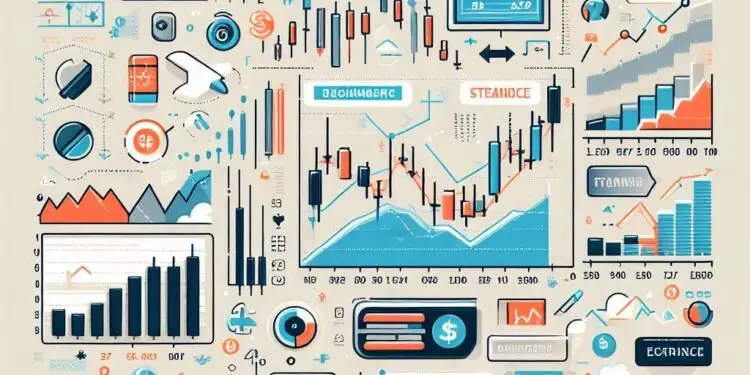How to Read Forex Charts, So you have heard approximately the Forex market. Maybe you’ve visible investors sharing their wins on-line, or you’ve come upon buying and selling apps promising the arena. But each time you open a Forex chart, it looks as if a jumble of perplexing traces, candles, and numbers. Sound acquainted?
Don’t fear—you’re not on my own. Learning to examine Forex charts can sense overwhelming in the beginning. But after you recognize the fundamentals, those charts turn out to be one of the most powerful equipment at your disposal as a dealer.
This guide is written with beginners in thoughts. Whether you’re just curious or ready to dive into buying and selling, here’s a clean, no-fluff breakdown of the way to examine Forex charts and make sense of what you’re seeing.
What Is a Forex Chart?
Let’s start with the fundamentals.
A Forex chart is a visible illustration of the charge movements of foreign money pairs over a positive period of time. Think of it as a timeline that indicates how one foreign money is performing towards some other—like the EUR/USD or GBP/JPY.
These charts help buyers see styles, spot tendencies, and make selections based totally on price conduct. Simply placed, a Forex chart is your roadmap in the trading global.
Types of Forex Charts
Before we dig into how to study them, permit’s examine the 3 primary varieties of Forex charts:
Line Chart
- The simplest of all charts.
- It shows the last costs of a foreign money pair through the years.
- Easy to apprehend, but doesn’t offer much element.
✅ Best for: Beginners who need a clean assessment of the market.
Bar Chart
- Displays the open, excessive, low, and close (OHLC) for on every occasion period.
- Gives you a clearer experience of fee volatility.
✅ Best for: Intermediate buyers wanting greater statistics than line charts provide.
3. Candlestick Chart
- Most normally used chart in Forex buying and selling.
- Combines the identical records as bar charts but in a visually intuitive way.
- Each “candle” shows rate motion for a selected length.
✅ Best for: All levels—mainly beneficial for identifying market psychology.
If you’re just starting out, stick with candlestick charts. They’re less difficult to read once you get the cling of them.
Understanding the Basics of a Candlestick
Here’s a quick breakdown of the way to examine a single candlestick:
- Body: The thick part of the candle suggests the hole and final fees.
- Wick (or Shadow): The thin lines above and underneath display the excessive and occasional costs.
- Color: Typically, green (or white) candles mean fee went up, at the same time as red (or black) means charge went down.
Once you apprehend this, studying rate motion will become loads easier.
Timeframes: What They Mean
Forex charts are divided into one of a kind timeframes—each candle or bar represents a selected time period. Common ones consist of:
- 1 minute (M1): Super quick-time period
- 15 mins (M15): Good for day buying and selling
- 1 hour (H1): Popular amongst swing traders
- 4 hours (H4): Great for catching medium-term tendencies
- Daily (D1): Ideal for long-time period trading
💡 Tip: Beginners ought to start with the 1-hour or day by day chart to get a clearer feel of the market without too much noise.
How to Spot Trends
One of the first things to search for on any chart is the trend. Is the marketplace:
- Going up? (Uptrend)
- Going down? (Downtrend)
- Going sideways? (Range)
You don’t need fancy indicators to look this. Zoom out, have a look at the general route of the candles, and draw a simple line connecting the lows in an uptrend or the highs in a downtrend.
Trading with the fashion is one of the golden guidelines for novices—it offers you a higher threat of achievement.
Support and Resistance Levels
These are key charge areas wherein the marketplace tends to bounce:
- Support is a charge stage in which a falling marketplace tends to prevent and reverse.
- Resistance is a stage wherein a growing market hits a ceiling and pulls lower back.
You can spot those through seeking out regions in which charge repeatedly reversed inside the past. Mark those ranges in your chart—they’re gold.
Volume and Volatility
While now not continually shown on the Forex market charts with the aid of default, volume shows how lots of a forex pair is being traded. Higher volume commonly means more potent traits.
Volatility tells you the way a lot charge is transferring. Big candlesticks with long wicks = excessive volatility. Smaller candles = low volatility.
Understanding this enables you gauge hazard and choose the proper moments to go into or go out a alternate.
Use Indicators (But Don’t Overdo It)
Chart signs are gear that help interpret fee actions. Popular ones for novices include:
- Moving Averages: Smooth out charge trends
- RSI (Relative Strength Index): Measures overbought or oversold conditions
- MACD: Highlights trend course and momentum
Use one or two indicators max—your chart shouldn’t look like a rainbow spaghetti.
Putting It All Together: A Simple Reading Routine
Here’s a newbie-friendly technique to reading a Forex chart:
- Identify the fashion
- Mark support/resistance stages
- Watch for candlestick patterns (like Doji, Engulfing, etc.)
- Check volume and volatility
- Use 1–2 indicators for confirmation
If the entirety traces up, you can have observed a solid trading possibility.
Mistakes to Avoid When Reading Forex Charts
Let’s be sincere—every dealer messes up in the starting. Here are a few common pitfalls to avoid:
- Overanalyzing – Simpler is often higher.
- Ignoring the trend – Don’t change against it.
- Relying most effective on signs – Price movement is your primary manual.
- Not practising on a demo account – Always test your chart analyzing earlier than going stay.
Remember, studying charts is a component talent and part intuition—each broaden over time.
Final Thoughts: Mastering the Forex Chart
Learning to examine Forex charts is like studying a new language. At first, the whole thing seems ordinary. But with exercise, patterns start to emerge, and your confidence grows.
Start by way of focusing on candlestick charts, identify developments, and maintain your evaluation easy and simple. Over time, you’ll start to see possibilities that others pass over.
📌 And in case you’re serious about becoming a higher dealer, chart analyzing isn’t non-obligatory—it’s critical.
So go in advance, open your buying and selling app, load up a chart, and take your first step. Because the more charts you read, the better you exchange.













I would like to thnkx for the efforts you’ve put in writing this web site. I am hoping the same high-grade website post from you in the upcoming also. In fact your creative writing abilities has inspired me to get my own website now. Really the blogging is spreading its wings fast. Your write up is a good example of it.